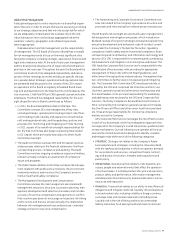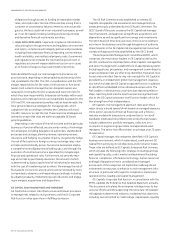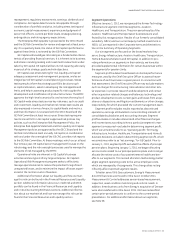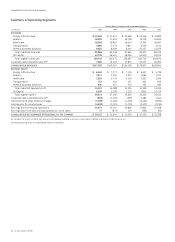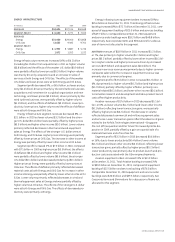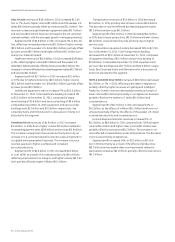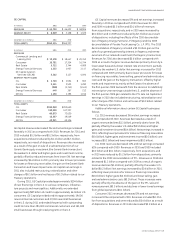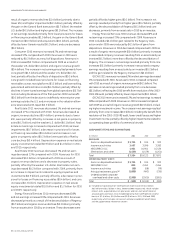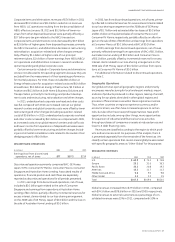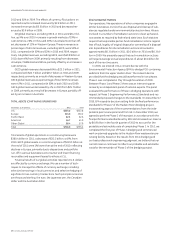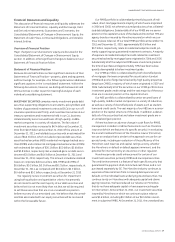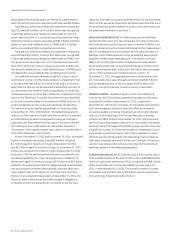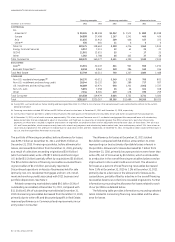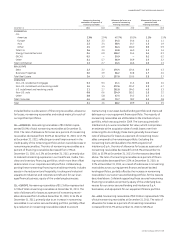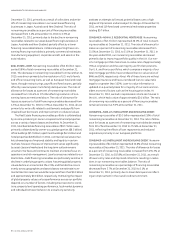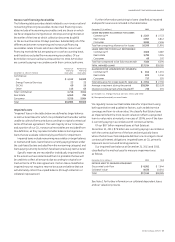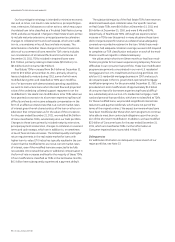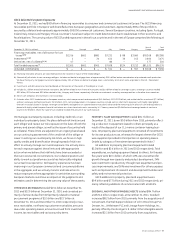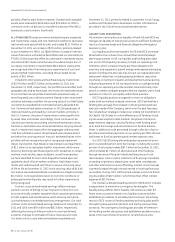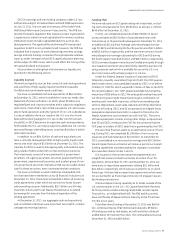GE 2011 Annual Report Download - page 51
Download and view the complete annual report
Please find page 51 of the 2011 GE annual report below. You can navigate through the pages in the report by either clicking on the pages listed below, or by using the keyword search tool below to find specific information within the annual report.’
GE 2011 ANNUAL REPORT 49
Financial Resources and Liquidity
This discussion of fi nancial resources and liquidity addresses the
Statement of Financial Position, Liquidity and Borrowings, Debt
and Derivative Instruments, Guarantees and Covenants, the
Consolidated Statement of Changes in Shareowners’ Equity, the
Statement of Cash Flows, Contractual Obligations, and Variable
Interest Entities.
Overview of Financial Position
Major changes to our shareowners’ equity are discussed in the
Consolidated Statement of Changes in Shareowners’ Equity
section. In addition, other signifi cant changes to balances in our
Statement of Financial Position follow.
Statement of Financial Position
Because GE and GECS share certain signifi cant elements of their
Statements of Financial Position—property, plant and equipment
and borrowings, for example—the following discussion addresses
signifi cant captions in the “consolidated” statement. Within the
following discussions, however, we distinguish between GE and
GECS activities in order to permit meaningful analysis of each
individual consolidating statement.
INVESTMENT SECURITIES comprise mainly investment grade debt
securities supporting obligations to annuitants, policyholders and
holders of guaranteed investment contracts (GICs) in our run-off
insurance operations and Trinity, and investment securities at our
treasury operations and investments held in our CLL business
collateralized by senior secured loans of high-quality, middle-
market companies in a variety of industries. The fair value of
investment securities increased to $47.4 billion at December 31,
2011 from $43.9 billion at December 31, 2010. Of the amount at
December 31, 2011, we held debt securities with an estimated fair
value of $46.3 billion, which included corporate debt securities,
asset-backed securities (ABS), residential mortgage-backed secu-
rities (RMBS) and commercial mortgage-backed securities (CMBS)
with estimated fair values of $26.1 billion, $5.0 billion, $2.6 billion
and $2.8 billion, respectively. Net unrealized gains on debt securi-
ties were $3.0 billion and $0.6 billion at December 31, 2011 and
December 31, 2010, respectively. This amount included unrealized
losses on corporate debt securities, ABS, RMBS and CMBS of
$0.6 billion, $0.2 billion, $0.3 billion and $0.2 billion, respectively, at
December 31, 2011, as compared with $0.4 billion, $0.2 billion,
$0.4 billion and $0.2 billion, respectively, at December 31, 2010.
We regularly review investment securities for impairment
using both qualitative and quantitative criteria. We presently
do not intend to sell the vast majority of our debt securities and
believe that it is not more likely than not that we will be required
to sell these securities that are in an unrealized loss position
before recovery of our amortized cost. We believe that the unreal-
ized loss associated with our equity securities will be recovered
within the foreseeable future.
Our RMBS portfolio is collateralized primarily by pools of indi-
vidual, direct mortgage loans (a majority of which were originated
in 2006 and 2005), not other structured products such as collateral-
ized debt obligations. Substantially all of our RMBS are in a senior
position in the capital structure of the deals and more than 75% are
agency bonds or insured by Monoline insurers (on which we con-
tinue to place reliance). Of our total RMBS portfolio at December 31,
2011 and December 31, 2010, approximately $0.5 billion and
$0.7 billion, respectively, relate to residential subprime credit, pri-
marily supporting our guaranteed investment contracts. A majority
of exposure to residential subprime credit related to investment
securities backed by mortgage loans originated in 2006 and 2005.
Substantially all of the subprime RMBS were investment grade at
the time of purchase and approximately 70% have been subse-
quently downgraded to below investment grade.
Our CMBS portfolio is collateralized by both diversifi ed pools
of mortgages that were originated for securitization (conduit
CMBS) and pools of large loans backed by high quality properties
(large loan CMBS), a majority of which were originated in 2007 and
2006. Substantially all of the securities in our CMBS portfolio have
investment grade credit ratings and the vast majority of the secu-
rities are in a senior position in the capital structure.
Our ABS portfolio is collateralized by senior secured loans of
high-quality, middle-market companies in a variety of industries,
as well as a variety of diversifi ed pools of assets such as student
loans and credit cards. The vast majority of our ABS are in a senior
position in the capital structure of the deals. In addition, substan-
tially all of the securities that are below investment grade are in
an unrealized gain position.
If there has been an adverse change in cash fl ows for RMBS,
management considers credit enhancements such as Monoline
insurance (which are features of a specifi c security). In evaluating
the overall creditworthiness of the Monoline insurer (Monoline),
we use an analysis that is similar to the approach we use for cor-
porate bonds, including an evaluation of the suffi ciency of the
Monoline’s cash reserves and capital, ratings activity, whether
the Monoline is in default or default appears imminent, and the
potential for intervention by an insurance or other regulator.
Monolines provide credit enhancement for certain of our
investment securities, primarily RMBS and municipal securities.
The credit enhancement is a feature of each specifi c security that
guarantees the payment of all contractual cash fl ows, and is not
purchased separately by GE. The Monoline industry continues to
experience fi nancial stress from increasing delinquencies and
defaults on the individual loans underlying insured securities. We
continue to rely on Monolines with adequate capital and claims
paying resources. We have reduced our reliance on Monolines
that do not have adequate capital or have experienced regula-
tor intervention. At December 31, 2011, our investment securities
insured by Monolines on which we continue to place reliance
were $1.6 billion, including $0.3 billion of our $0.5 billion invest-
ment in subprime RMBS. At December 31, 2011, the unrealized loss


